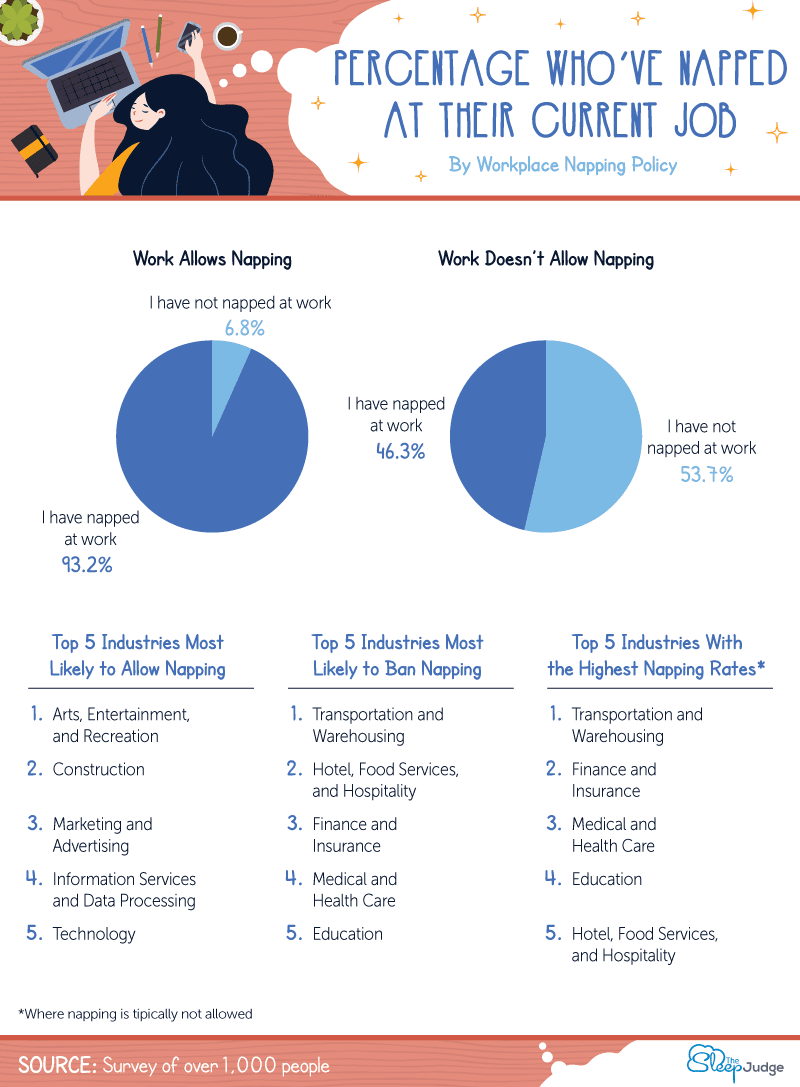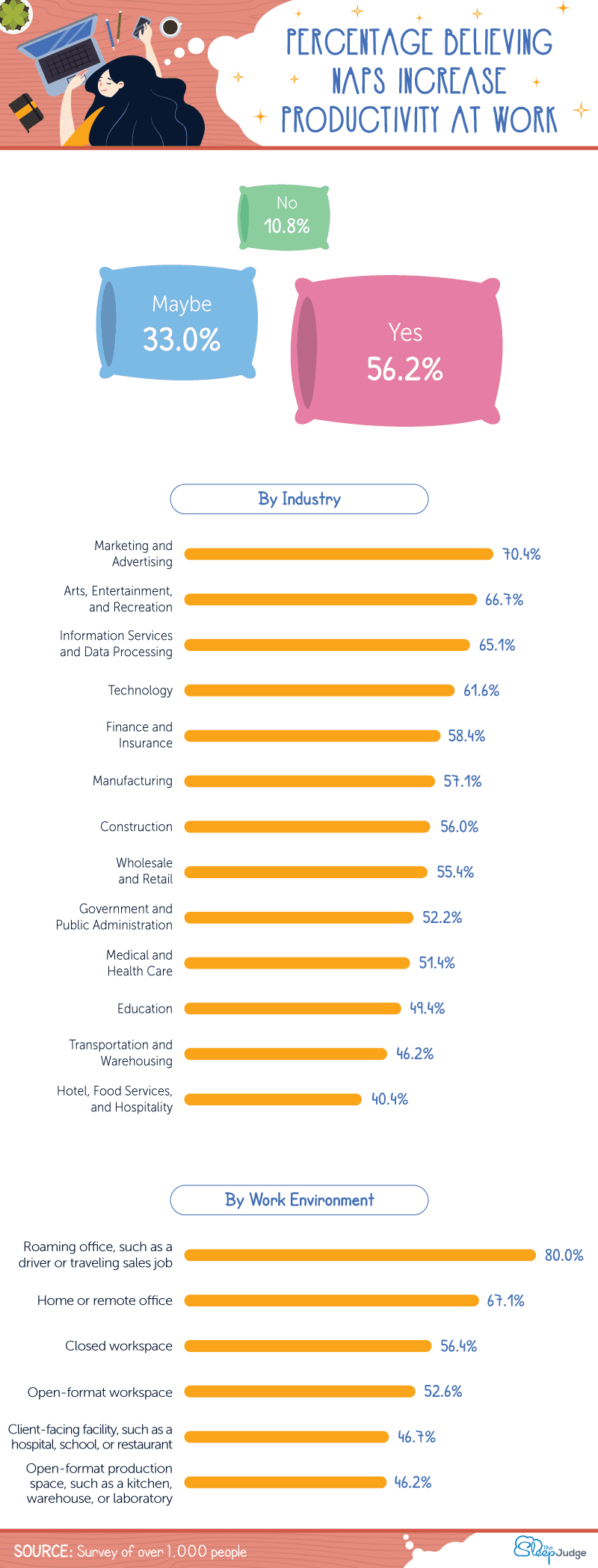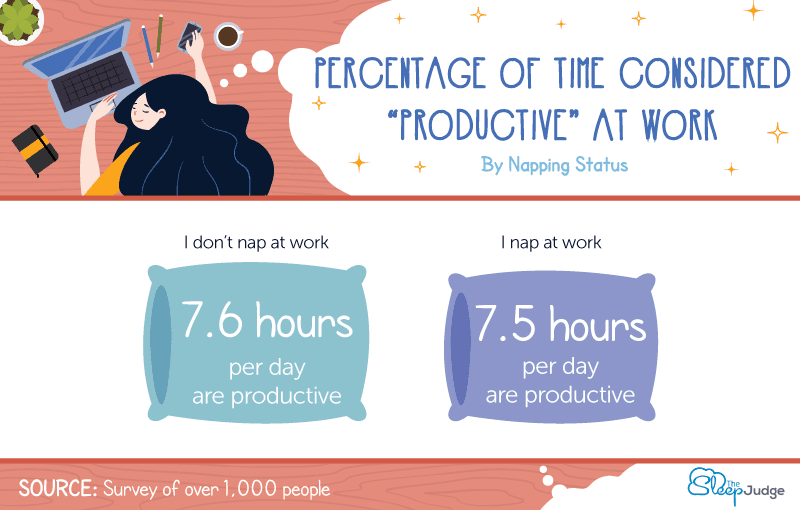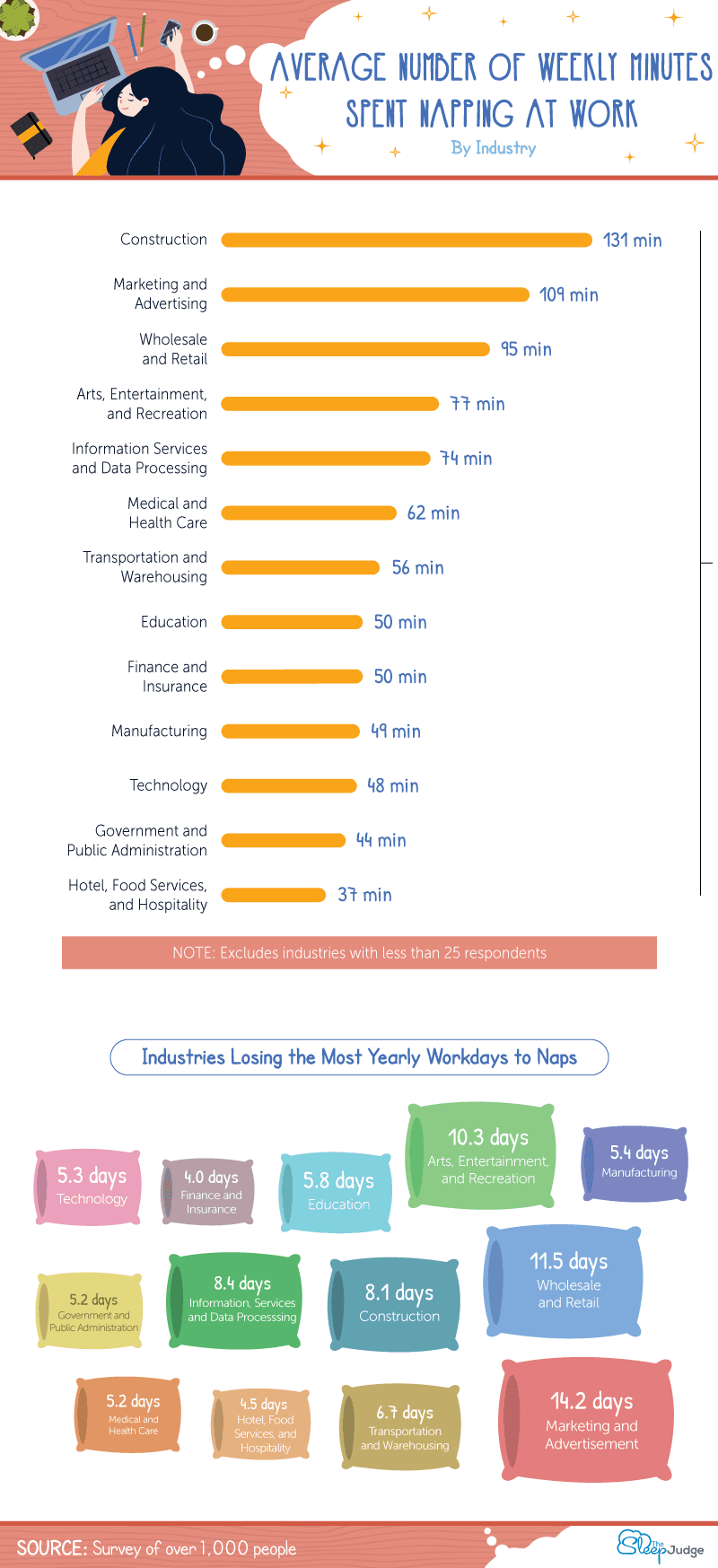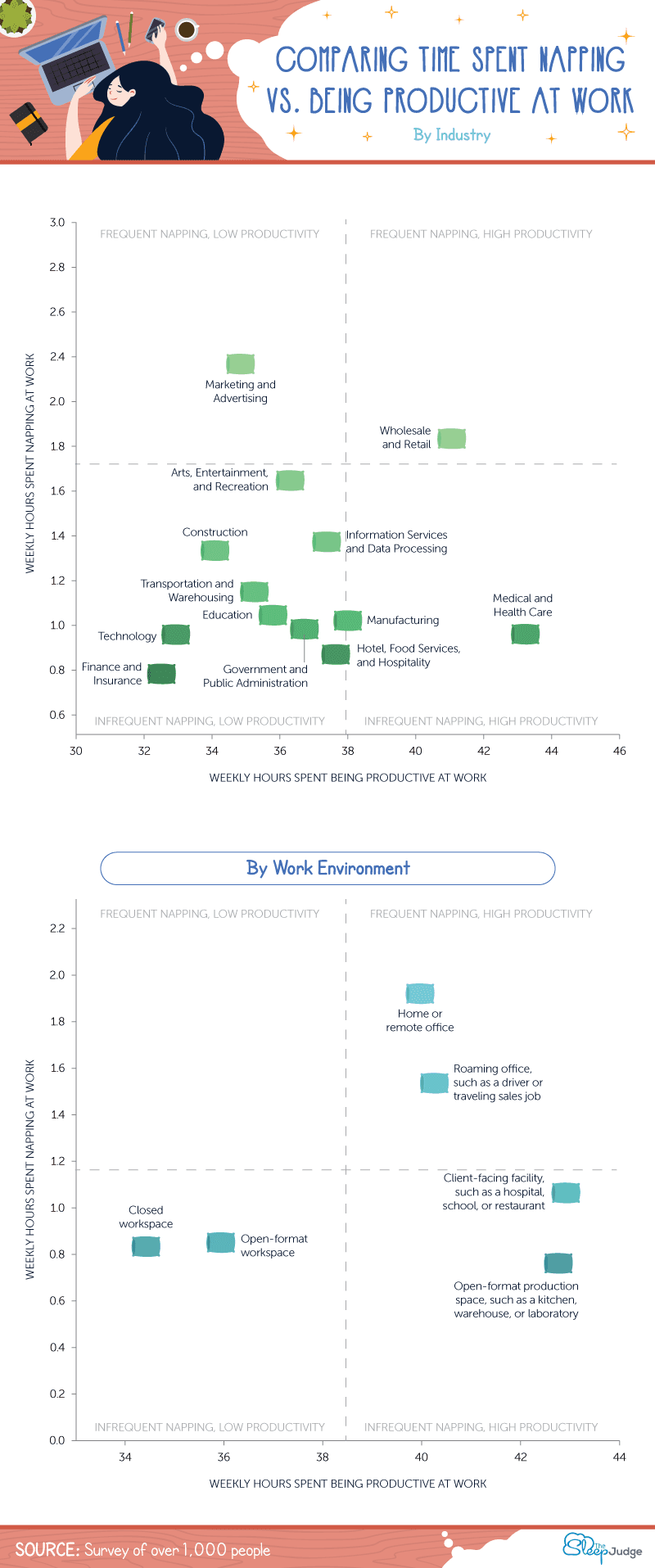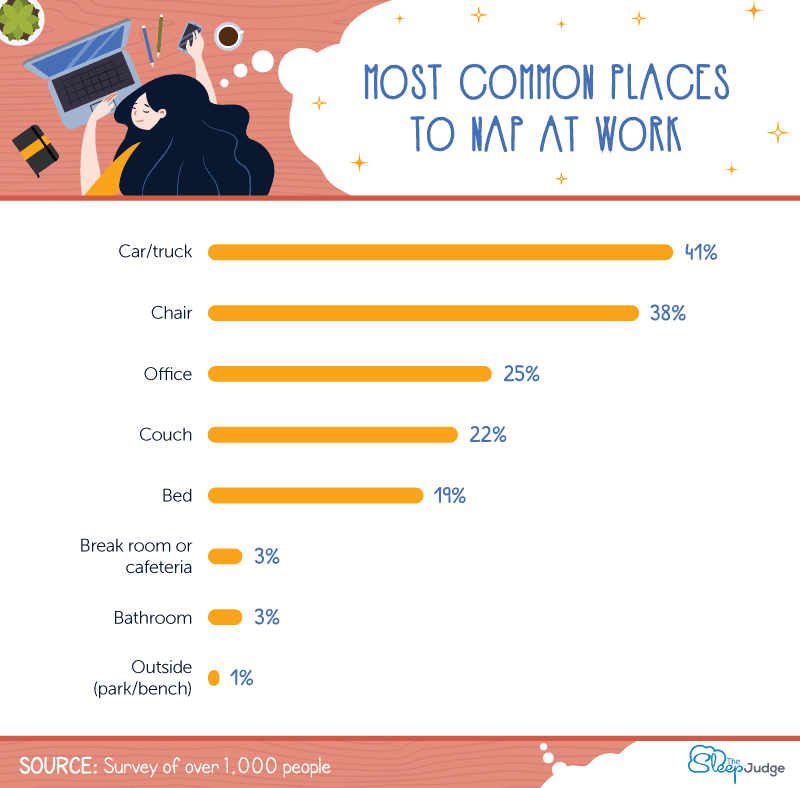Once upon a time, naps were an integral part of a person’s day. Whether you liked it or not, there were dedicated afternoon hours during which you were expected to sleep to stay energized for the evening.Of course, once you graduated from kindergarten, everything changed (at least in some countries, that is).
In hindsight, maybe we should have been more grateful for when afternoon naps were the norm rather thanthe exception. Thankfully, attitudes toward napping during the day have evolved. Now, experts say sleeping during the day – even while at work – can be good for you. Nap pods and quiet rooms are springing up all over the country, and the taboo once associated with falling asleep during lunch is quickly turning into expert advice.
Which jobs are leading the naptime revolution, and how many people are taking advantage of it? To find out, we polled over 1,000 people about whether they were allowed to sneak in a few extra zzz’s around the office, if those naps helped boost their productivity, and how you might be able to get in on the action– even if napping isn’t an official office policy just yet. Read on to learn more.
Serious Shut-Eye
If someone told you it was okay to crash at your desk during lunch or that there was a quiet room in the office dedicated to napping, would you take advantage of it?
Like most people, the answer is probably yes. Over 93 percent of people whose jobs allowed napping admitted to getting some boss-approved shut-eye. Naps at work were most likely to occur for people working in construction, marketing, arts and entertainment, and IT services.
In some cases, people whose jobs didn’t necessarily offer the same leniency did the same. While people working in transportation and warehousing, hospitality, and finance were the most likely to be banned from sleeping during work hours, they still had some of the highest napping rates.
Napping (Most People Believe) Isn’t So Bad
Sleeping on the job isn’t just about trying to sneak in a few extra minutes of rest: Research has shown even a short nap can have a positive impact on the rest of your day. Napping can help boost your immune system and improve your overall alertness, stamina, and memory.
According to 56 percent of people in our survey, napping at work can make you more productive as well. By taking a few minutes to recharge, you could wake up feeling energized enough to tackle the rest of the day. While roughly 1 in 3 people were unsure how napping affected their efficiency, less than 11 percent said napping didn’t make them more productive at work.
People working on the road, including drivers and those with traveling sales jobs, had the highest positive opinion of napping and productivity. Even 67 percent of people who worked from home or in a remote office said napping made them more productive.
Feeling productive at work doesn’t necessarily mean getting as much done as everyone else. While a vast majority of nappers said having just a few extra minutes of rest during the day helped boost their efficiency around the office, people who didn’t nap at all reported getting slightly more done with their time.
Down for the Count
Whether or not their shut-eye is sanctioned, people working in construction spent more time napping at work than anyone else. At an average of 131 minutes every week, that potentially unapproved time off the floor equates to more than three workweeks per year napped away.
People working in the marketing and advertising industries also reported napping for 109 minutes around the workplace every week on average, followed by wholesale and retail (95 minutes), arts and entertainment (77 minutes), an d IT and data processing (74 minutes). While that time amounts to several days or weeks of lost time over the course of a year, the added benefits to the immune system and people’s cognitive capacities could help make up for that lost time in other ways.
Too Much of a Good Thing
When it comes to advocating for naptime around the office, more may not always be better.
Marketing and advertising, the industry with the second-highest amount of time spent napping per week, also reported one of the lowest weekly rates of productivity at around 35 hours. In contrast, the similarly heavy-napping retail industry reported over 40 hours of productivity per week. People in the medical industry reported the highest productivity, meaning they get a lot done and nap very little during the workweek.
Your office layout may have something to do with overall napping productivity, too. People working from home or a remote office got more sleep at work than anyone else, but they made up for it by reporting a higher number of productive hours throughout the week. People working in traditional workplaces seemed to get the least done, and interestingly enough, there wasn’t much of a difference between open-format and closed workspaces.
Making Do
If your office doesn’t have a swanky nap room or meditation lounge to grab a few minutes of shut-eye, you’re probably not alone. Forty-one percent of people who found time to nap at work slept in their cars or trucks instead, and 38 percent slept in a chair (presumably) at their desks.
While 1 in 4 people said they slept in an office, 22 percent napping on a couch, and nearly 1 in 5 napped in a bed. For others, the options might have been even scarcer – 3 percent said they napped in the bathroom or break room, and 1 percent found time to sneak in a few minutes of rest outside, either in a park or on a bench.
You may be interested in: Sleep Cycle Naps
The Final Verdict
Making a case for why sleeping should be an approved office behavior isn’t just a trendy spin on the modern workplace – it has scientific benefits that could help boost overall productivity in the long run.
It’s always possible to have too much of a good thing, but our survey revealed people who clocked in more sleep did not show any significant reduction in estimated hours of productivity per day. Even if you have to catch those zzz’s in your car during a lunch break, they could be worth sneaking in here or there.
Methodology
We surveyed 1,678 people. Of these respondents, 805 individuals were considered full time and were included in the analysis listed here. Fifty percent of respondents were men, and 49.7 percent of respondents were women. Less than 0.4 percent considered themselves nonbinary. 43.7 percent of respondents worked in an open-format office, 27.1 percent worked in a closed office space, 17.3 percent worked at home or in a remote office, and 11.9 percent listed their office category as “other.” The average age of respondents was 35.3 years, with a standard deviation of 10.2 years. In addition, 65.6 percent of respondents reported having taken at least one nap in the workplace.
About Us
Our team at The SleepJudge helps you find the best sleep products with our in-depth reviews. We explore and report on issues relating to sleep, and make specific recommendations on the best memory foam mattresses for your sleeping habits, body type, and lifestyle.
Fair Use Statement
No need to nap on this one. Feel free to share the results of our study with your readers for any noncommercial use. Out of respect to our contributors, we only ask that you ensure a link back to this page, too.

